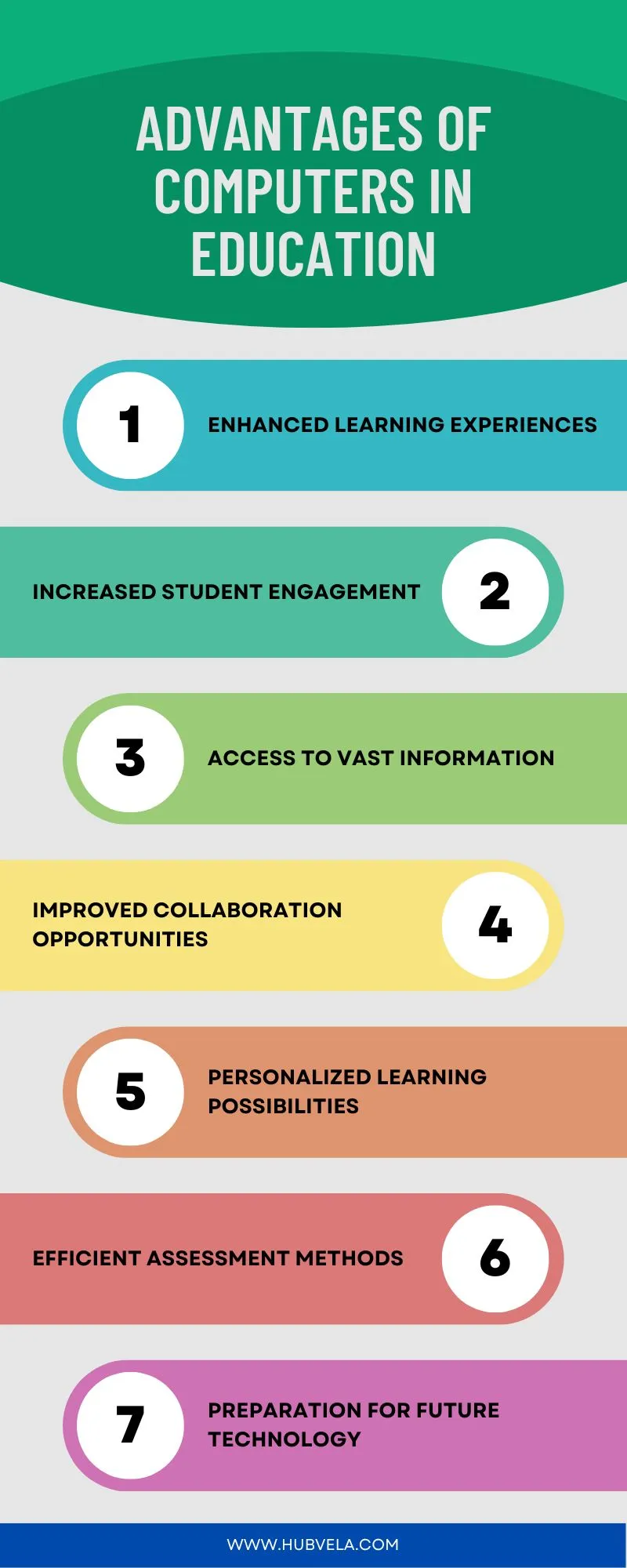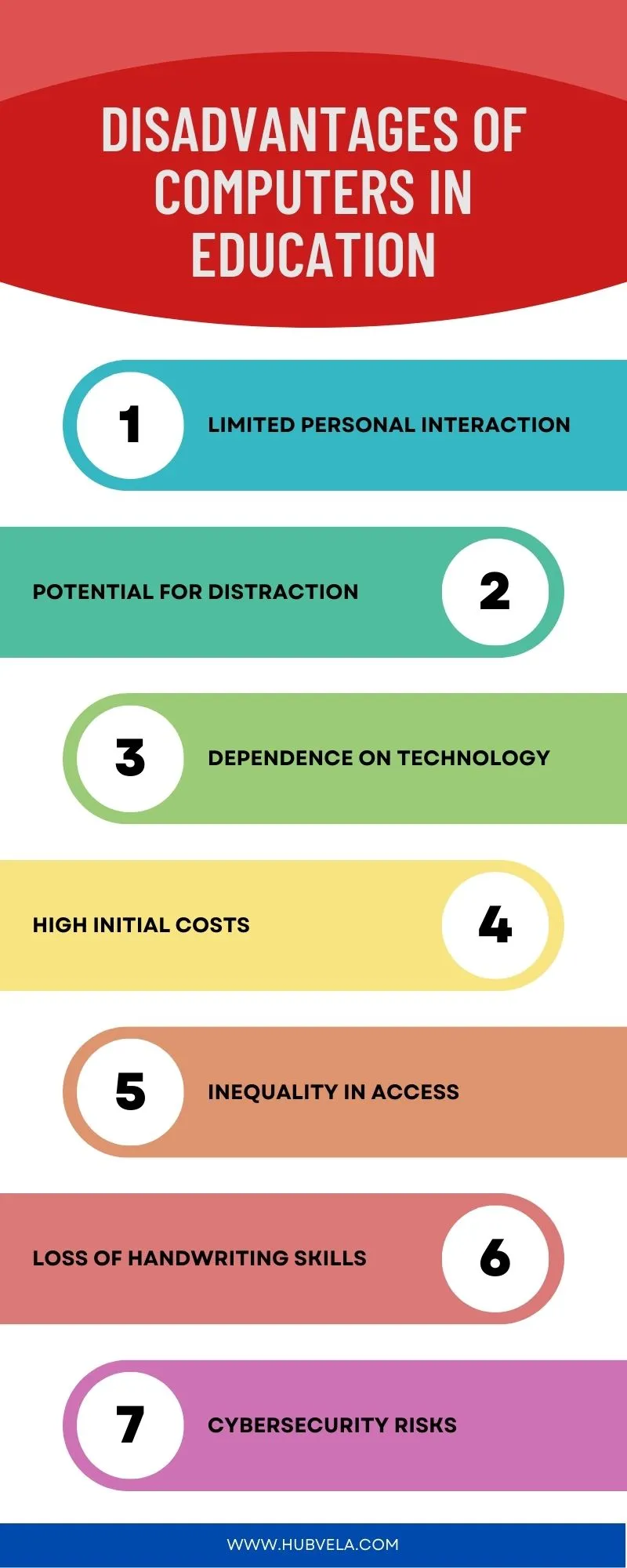Do you want to know the incredible impact that computers have on education? Well, get ready to be amazed!
Computers bring a whole new level of learning experiences and student engagement. With just a few clicks, you have access to a vast amount of information, expanding your knowledge like never before. Collaboration becomes easier, allowing you to work together with classmates effortlessly.
However, like everything in life, there are some downsides to consider. Not everyone has equal access to computers, creating inequality in education. Additionally, relying too much on computers may result in the loss of valuable handwriting skills. And let’s not forget about the cybersecurity risks that come along.
So, let’s dive deeper into the advantages and disadvantages of computers in education and find out if they truly live up to the hype!

--Advertisement--
Advantages of Computers in Education
Computers have become an essential tool in modern education, offering numerous benefits that enhance the learning experience and improve student outcomes. Some of the key advantages of computers in education include:

1. Enhanced Learning Experiences
With computers, you can enhance your learning experiences in education.
Virtual simulations, interactive lessons, gamified learning, online resources, and blended learning are all advantages that computers bring to the educational environment.
Through virtual simulations, students can engage in hands-on experiences that would otherwise be impossible.
Interactive lessons allow for active participation and immediate feedback.
Gamified learning makes education more enjoyable and motivates students to learn.
Online resources provide a wealth of information at your fingertips.
Blended learning combines traditional classroom instruction with online learning, offering flexibility and personalized learning opportunities.
2. Increased Student Engagement
By utilizing computers in education, you can significantly enhance student engagement. Technology integration allows students to actively participate in their learning process, promoting active learning.
The use of gamification benefits students by making their learning experience more enjoyable and interactive. Interactive lessons, through the use of computers, provide students with a hands-on approach to their education, further increasing their motivation to learn.
3. Access to Vast Information
You can expand your knowledge and access a wealth of information through the use of computers in education. With the internet at your fingertips, you can easily research and learn about any subject of interest.
However, there are some drawbacks to consider. Internet dependency can lead to a reliance on online sources without developing critical thinking skills. Additionally, information overload can make it difficult to discern credible sources.
The digital divide may also limit access to information for those with limited technology resources. Lastly, increased reliance on computers may reduce social interaction in the classroom.
4. Improved Collaboration Opportunities
Computers in education offer enhanced collaboration opportunities, allowing students to actively engage and work together on various projects and assignments. Through group work, virtual classrooms, and online collaboration tools, students can engage in cooperative learning and benefit from the diverse perspectives and skills of their peers.
This not only fosters teamwork and communication skills, but also encourages critical thinking and problem-solving abilities. Additionally, remote learning has become more accessible, enabling students to collaborate with peers from different locations and backgrounds.
5. Personalized Learning Possibilities
With computers in education, you can benefit from personalized learning opportunities.
The use of technology allows for adaptive instruction, where the curriculum is customized to meet your specific needs and abilities.
You receive individualized feedback, helping you understand your strengths and weaknesses.
Computers also offer tailored learning paths, allowing you to progress at your own pace and explore subjects in depth.
These personalized learning benefits empower you to take control of your education and achieve academic success.
6. Efficient Assessment Methods
One advantage of using computers in education is the ability to employ efficient assessment methods.
Computers allow for formative assessment through online quizzes, which can be automatically graded. This saves time and provides immediate feedback to students.
Additionally, computers enable real-time feedback, allowing students to track their progress and make adjustments accordingly.
Adaptive learning, a feature of computer-based assessments, tailors the questions and content to each student’s individual needs, further enhancing the efficiency of the assessment process.
7. Preparation for Future Technology
Get ready for the future by incorporating computers into your education.
With the rapid advancement of technology, it’s crucial to prepare for the future by developing technological skills and digital literacy.
By using computers in education, you can enhance your job market readiness and stay ahead in a technology-driven world.
Moreover, the innovation in teaching methods facilitated by computers can provide a dynamic and engaging learning experience for students.
Disadvantages of Computers in Education
The use of computers in education has been a significant development in recent years, but it has also introduced some disadvantages that need to be addressed.
We will discuss the various drawbacks of computers in education and how they can impact the learning experience for students.

1. Limited Personal Interaction
You may rarely have the opportunity to engage in personal interactions when using computers in education. While online communication can provide a platform for discussion, it lacks the nuances of face-to-face interaction. This limited personal interaction can hinder the development of social skills, classroom dynamics, and critical thinking.
Additionally, the absence of direct student-teacher relationships can impact the quality of education, as the teacher’s guidance and individualized support may be compromised.
2. Potential for Distraction
The potential for distraction in using computers for education can be a significant drawback, hindering focus and productivity. Without proper distraction management, students may find it challenging to maintain their attention span and stay engaged in their studies.
Additionally, the internet poses risks to online safety, and students need to develop digital literacy skills to navigate these potential dangers.
Ultimately, excessive distractions can negatively impact academic performance and hinder educational progress.
3. Dependence on Technology
One of the disadvantages of computers in education is the potential for a student’s dependence on technology. Technology reliance can lead to an educational dependency, where students rely solely on computers for their learning. This can exacerbate the digital divide, as not all students have equal access to technology.
Additionally, excessive screen time can raise concerns about the impact on critical thinking skills. It’s important to strike a balance and ensure that technology is used as a tool rather than a crutch in education.
4. High Initial Costs
While it may seem like a worthwhile investment, it’s important to consider the high initial costs associated with incorporating computers into education.
However, these costs shouldn’t overshadow the long-term benefits and cost effectiveness that technological advancements can bring.
By providing students with access to computers, schools can promote digital literacy and optimize resources.
Although the initial investment may be high, the potential for improved learning outcomes and resource utilization makes it a valuable investment in the future.
5. Inequality in Access
To ensure equal access to computer education, it’s essential for schools to address the issue of inequality in access. The digital divide and educational inequalities contribute to a technological disadvantage for students who lack access to computers.
Unequal access to computers and inequitable resources further exacerbate this problem. Without equal access to computers, students are at a disadvantage in acquiring important technological skills and keeping up with the demands of the modern world.
It’s crucial for schools to bridge this gap and provide equal opportunities for all students.
6. Loss of Handwriting Skills
You may experience a decline in your handwriting skills due to the increased use of computers in education. The loss of fine motor skills, which are essential for writing, can have a significant impact on cognitive development.
Additionally, relying heavily on computers can lead to decreased creativity and reduced critical thinking abilities.
Furthermore, the decline in spelling and grammar skills can be observed as students rely more on autocorrect and spell-check features.
It’s important to find a balance between digital and traditional writing methods to maintain these essential skills.
7. Cybersecurity Risks
Be cautious of the cybersecurity risks associated with using computers in education.
While computers offer numerous benefits in the classroom, it’s crucial to implement strong cybersecurity measures.
Data breaches, online privacy concerns, phishing attacks, and other threats can compromise the digital safety of students and educators.
To mitigate these risks, schools must prioritize cybersecurity education, regularly update software and security systems, and enforce strict privacy policies.
Conclusion on Advantages and Disadvantages of Computers in Education
In conclusion, computers have both advantages and disadvantages in education. While technology can enhance the learning experience, improve concentration, and promote student flexibility, it can also lead to distractions, reduced socialization, and increased reliance on digital tools.
As a result, it is essential for educators to strike a balance between incorporating technology into the classroom and ensuring that students develop the necessary skills to use these tools responsibly.


